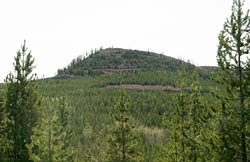
Brunisols are often found in forest ecosystems such as one at Nazko Cone located about 150 km southwest of Prince George, BC.
Brunisols (or Inceptisols in USDA Soil Taxonomy) have enough horizon development to exclude them from Regosols but lack sufficient development required for other soil orders. Brunisolic soils can be viewed as a stage in an evolutionary sequence that begins with an unweathered parent material (Regosolic soils) and ends with development of a “mature” soil (e.g., of the Podzolic or Luvisolic orders). Several horizon types are used as diagnostic horizons for the Brunisolic order (although all must be at least 5 cm thick). The main horizon associated with the Brunisolic order is the Bm horizon (a horizon that has undergone minimal pedogenic alteration), while others include Bfj, Btj, and Bhjfj.
The four great groups of the Brunisolic order are distinguished on the basis of pH and presence of an Ah (or equivalent Ap) horizon.
Melanic Brunisol Great Group
Soils of this great group have pH ≥ 5.5 and Ah (or Ap) ≥ 10 cm in thickness.
Eutric Brunisol Great Group
Soils of this great group have pH ≥ 5.5 and Ah (or Ap) < 10 cm in thickness or absent.
Sombric Brunisol Great Group
Soils of this great group have pH < 5.5 and Ah (or Ap) ≥ 10 cm in thickness.
Dystric Brunisol Great Group
Soils of this great group have pH < 5.5 and Ah (or Ap) < 10 cm in thickness or absent.